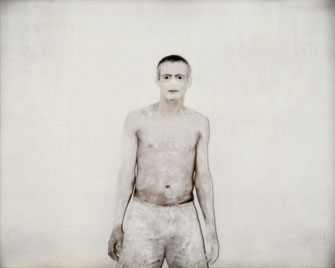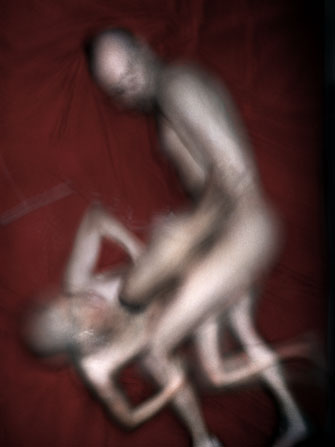A Baffling, Freewheeling
Vision of Human Hell

”Marseille” (1997) © Antoine d’Agata-Magnum photos. Courtesy Galerie Les Filles du Calvaire, Paris
Art is not always meant to uplift. The task of an exhibition is just as much to open visitors’ eyes to the more somber aspects of the human condition as it is to reinvigorate their appetite for life. “Anticorps,” the latest photography show to open at Le Bal in the 18th arrondissement, offers a vision of man so chillingly unforgiving, so bleak and reductive, that it will remain branded upon the consciousness long after memories of the images themselves have faded.
Antoine D’Agata, the Marsellais photographer who took most of the pictures in the show (his photos are mingled with images from police files and the Internet), fixes his gaze upon the human body, showing it contorted into gruesome shapes or naked and vulnerable. Many of the photographs recall the ghoul-like specters in Francis Bacon’s paintings, and, like Bacon, D’Agata tends to thread his images with the color red, leaving a trail of crimson splashes across the exhibition that link photographs taken on different continents and in different decades. One particularly memorable series shows a naked woman

“Phnom Penh” (2008) © Antoine d’Agata-Magnum photos. Courtesy Galerie Les Filles du Calvaire, Paris
writhing on a burgundy blanket, her features blurred and her limbs melted by the camera lens.
The show is laid out in a single large room, with photographs covering all four walls from floor to ceiling. The effect is overwhelming – there is no refuge for the eye, and little information is provided about the identities or backgrounds of the pictures’ subjects. A printout identifying them is available, but it offeris only factual details such as location and date rather than stories that might explain the distress of the individuals exposed.
“Anticorps” is an immersive exhibition – visitors descend into an inferno and are forced to confront a crowded canvas of diverse human suffering, as darkly fascinating as it is grisly. And D’Agata’s is not a hell anchored to some underlying faith in redemption or divine retribution – it is baffling, freewheeling. We see brothels wriggling with copulating couples, gray and featureless as corpses; we see soldiers, clutching guns like teddy-bears, standing sentinel before barren landscapes; we see Marseilles, as run down as a modern-day war zone, crumbling and ugly and damned.
The exhibition offers no let-up from the dose of misery administered by D’Agata. Yet it shows that shoots of beauty can also survive in the underworld, for though the subject matter of the photographs is unremittingly grim, many of the images exude a quiet elegance. D’Agata demonstrates that the human body is capable of transcendence and purity, but that it is extraordinarily vulnerable to corruption. It is this corruption that he exposes and criminalizes, suggesting, perhaps, that though the human body is man’s greatest weakness, it is also his greatest expressive instrument.
Le Bal: 6, impasse de la Défense, 75018 Paris. Tel.: 01 44 70 75 50. Open Wednesday-Friday, noon-8pm (Thursday until 10pm); Saturday, 11am-8pm; Sunday, 11am-7pm. Admission: €5. Through April 14. www.le-bal.fr
Reader reaction: Click here to respond to this article (your response may be published on this page and is subject to editing).
Please support Paris Update by ordering books from Paris Update’s Amazon store at no extra cost. Click on your preferred Amazon location: U.K., France, U.S.
More reviews of Paris art shows.
© 2013 Paris Update
